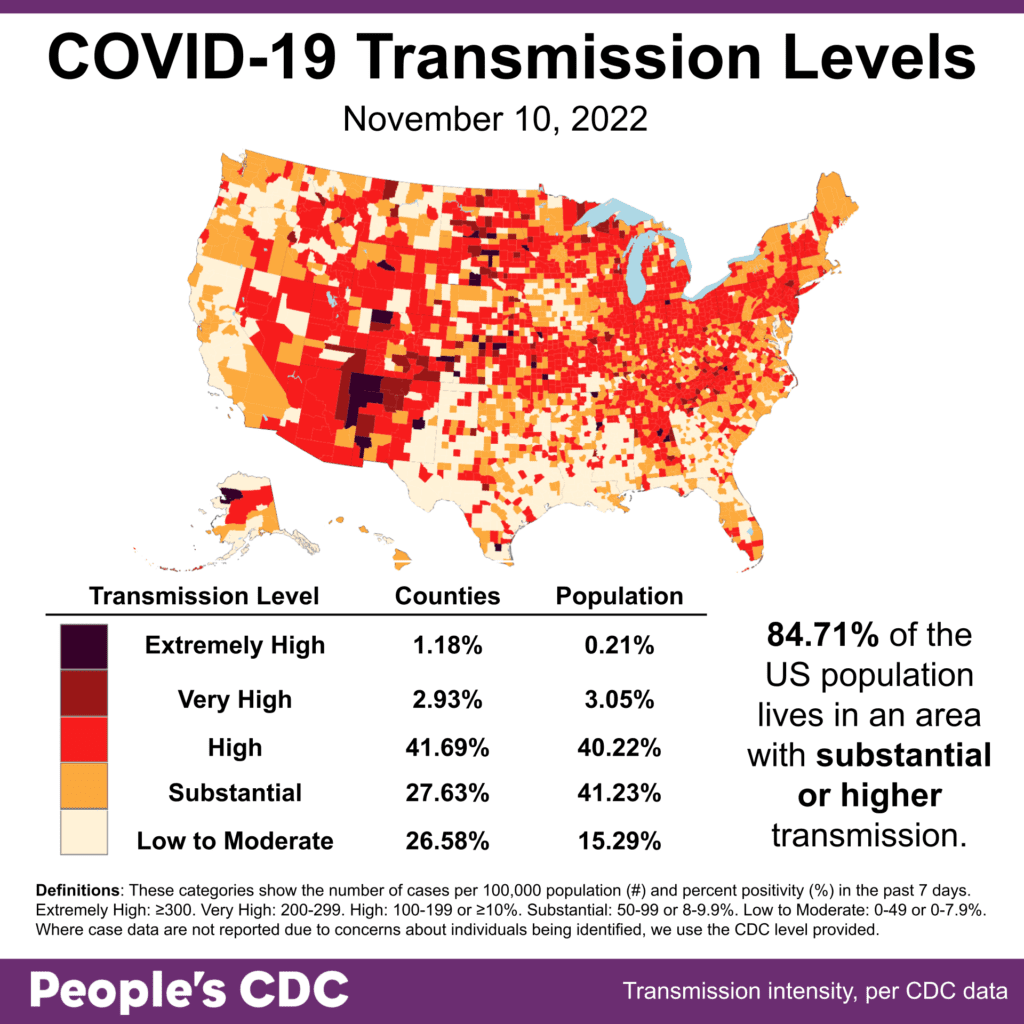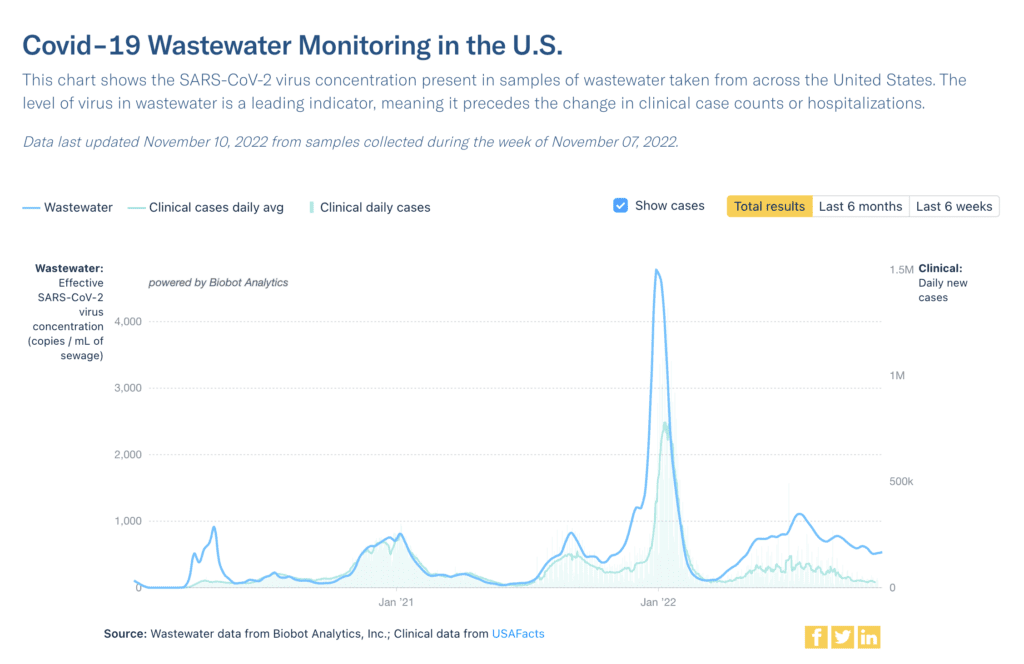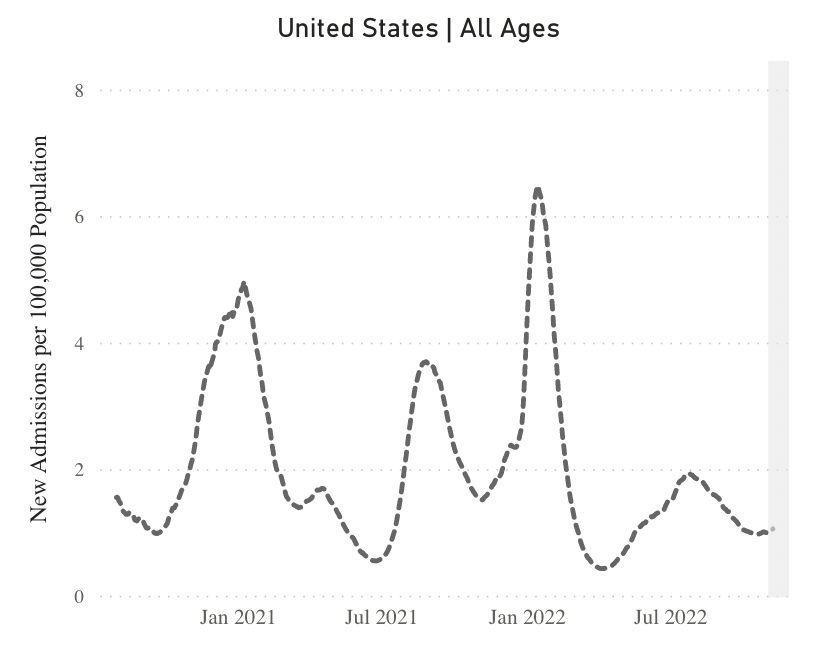The Weather: Transmission levels continue to increase, with 84.71% of the population currently living in areas with substantial or higher transmission.

On Variants: The variant picture continues to shift, with BA.5 proportions continuing to drop and BA.5 subvariants BQ.1.1 and BQ.1 continuing to rise.
BA.5 now represents only 29.7% of cases; in contrast, BQ1.1 and BQ.1 now represent a combined 44.2%, up from just 32.6% last week.

Wastewater Monitoring: After a slight dip last week, national wastewater levels have begun to increase once again.

Volunteers with the People’s CDC have compiled a new resource, “Wastewater Data FAQs,” which explains what it is, why it’s important, where it comes from, and the benefits and drawbacks of its use.
Vaccinations: New data from Pfizer on their bivalent Covid vaccine suggests their updated vaccine may be more protective against more recent Omicron subvariants than the original formula.
While vaccine hesitancy is often attributed to historical wrongs, medical racism is a persistent issue. For example, Black Americans who report having bad interactions with racist healthcare workers are more likely to be skeptical of COVID vaccines.
If you’re a healthcare worker, what are you doing to ensure you and your colleagues do not contribute to bad experiences faced by Black patients engaging with the medical system?
Hospitalizations: Following a relative plateau over the past several weeks, hospitalizations have also begun to rise again.

Infants, who are ineligible for vaccination, have high COVID–associated hospitalization rates compared to other children. Pregnant people should stay up to date with COVID vaccination & nonpharmaceutical measures should be used to help protect infants.
Deaths: Between November 2 and November 8, 2,344 people died of COVID nationally. Over 245,000 people have died of COVID in the US this year so far.
A preprint comparing mortality among youth 0-19 in 2019 to the past year found COVID among the top 10 leading causes of death. This directly refutes those who argue against protections for young people.
COVID ranked 8th among all causes, 5th in disease-related causes (excluding accidents, assault and suicide), and 1st in deaths caused by infectious or respiratory diseases for youth 0-19 years old.
On Long COVID: A German study found children and adolescents had higher long-term demand for health care services after COVID infection, meaning that Long COVID cannot be dismissed among children and adolescents.
A VA study found that COVID reinfection contributed additional risks of death, hospitalization, as well as pulmonary, cardiovascular, hematological, diabetes, gastrointestinal, kidney, mental health, musculoskeletal, and neurological disorders.
The risks of reinfection were evident regardless of vaccination status. The analysis did not assess severity of reinfection vs initial infection, but underlined that for people who already had a 1st infection, prevention of reinfection may protect from additional health risks.
The authors conclude with a position that mirrors that of @PeoplesCDC, stating that “Prevention of infection and reinfection with COVID should continue to be the goal of public health policy.”
A mouse model found cognitive deficits after COVID infection, suggesting the need for further study. The study showed similarities with changes in human neurodegenerative diseases which may suggest paths toward accurate diagnoses and treatments.
Forecast: A new preprint provides evidence that Paxlovid lowers the risk of Long COVID by around 25%.
@EricTopol provides an excellent breakdown of this new work on his blog, noting that more extensive research and replication is needed before determining whether Paxlovid is truly preventative.
The false notion of “immunity debt” continues to gain steam, despite loads of evidence that illnesses such as RSV and flu are likely due to post COVID immunity deficiencies.
Take Action: The recent elections have highlighted the importance of fighting for accessible voting.
Universal masking policies in schools work to prevent COVID transmission; we need to fight for universal masking in schools.
Fighting for accessible schools means preventing us from worrying we’ll be punished for caring about the health of ourselves, our children, and our neighbors.
Take action for #WorldAIDSDay on Dec 1st. Demand @POTUS Biden & Congress take urgent action to address colliding global+domestic pandemics: #HIV, #LongCOVID, COVID, Ebola, cholera,TB, and more.
Here is a thread with a YouTube video explaining how COVID works as a refresher before the holiday season.
This Petition to Pfizer demands expanding access to Paxlovid in Latin America. Viewers can hit the “translate to English” option in order to sign the petition.
Notes: 1) The numbers in this report were current as of 11/11. The CDC updates data frequently as it receives refreshed information. Today’s numbers may be slightly different from the data here. 2) Check out the links throughout & see our website for more! https://bej.gbh.mybluehost.me.